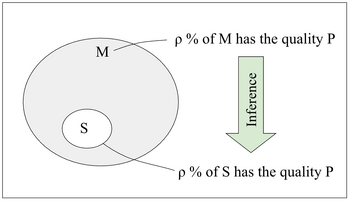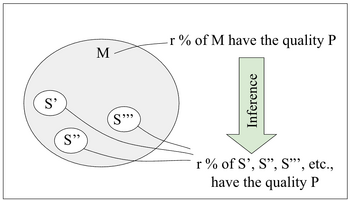Inferences Made on Signs
Introduction
The following article outlines five types of inference used with signs like those from assessment techniques, including GRI’s adaptive profiles. The same principles apply to any individual characteristics, such as social behavior, values, intelligence, and other concepts used to describe people. When starting to learn and use new signs, during initial training, we begin and continue afterward, making inferences that follow some principles. The learning and application of adaptive profiles follow this process. The same applies when learning a new language, sport, music, or even cooking. This same process has occurred in mathematics, software development, and physics, with any signs used—such as those for temperature, distance, and various measurement tools—to extend our capabilities.
The process of assigning meaning to signs is general and not new, but it is highlighted and becomes very important when studying individual characteristics and assessment techniques. This is especially true when relearning about social behavior, with adaptive profiles, challenging long-held beliefs about people, and comparing their learning and application with other methods.
The five general forms of inference introduced in this article are the following.
- Simple syllogism
- Probable deduction
- Statistical deduction
- Induction
- Hypothesis
Other forms of inference, such as abduction, are more subtle and are not discussed here. The ones presented here are more basic and sufficient for understanding the logic used when evaluating people’s characteristics, learning, and application. In the discussion below, “M” should be replaced with “groups of people,” and “S” with “individual person.” This synthesis is directly based on Charles Pierce's work on logic and its significant influence on semiotics—the study of signs and symbols and how they create and communicate meaning, as well as pragmatism[1].
Simple Syllogism
The Simple Syllogism corresponds to the following logic: “All M has the quality P – S is an M - therefore S has the quality P”. It can be represented as follows:
The simple syllogism is the quintessential form of canonical deductive reasoning. It should be compared with other forms of deduction and inference presented below.
Probable Deduction
The probable deduction corresponds to the following logic: The proportion ρ of M has the quality P - S is an M - It follows that S has the quality P with probability ρ.
The ratio ρ need not be specified exactly; it is subject to indeterminacy when one speaks, for example, of "a certain large quantity".
The differences between a simple syllogism and a probable deduction are the following:
- While the simple syllogism recognizes only the inclusion or non-inclusion of one class under another, the probable deduction takes into consideration the proportion of one class that is contained within another.
- For the existence of a simple syllogism, all that is required is that we are able to say that something is contained in another thing, or that an object stands for a second in a relation to the other. For the probable deduction, it is necessary that the P qualities be differentiated and counted so that the quantitative ratio can make sense.
- An essential distinction between the two kinds of inference is that in a simple syllogism, the conclusion depends on the existence of objective facts contained in the premises. In contrast, in the probable deduction, these facts in themselves do not make the conclusion probable, because one must take into account the way in which the premises were obtained. Good faith and honesty are essential for sound logic with a probable deduction. When the partial rule that the proportion ρ of M has quality P is used to show that S has quality P with probability ρ, it is required not only that S be M but also that S be a random instance among the M.
- The conclusions of the two modes of inference differ. One is necessary, the other is only probable. In the first case, we conceive that facts such as those expressed by the premises are never true unless some other fact in relation to them is likewise true. In the other case, we conceive that in our reasoning, we are following a general maxim which will usually lead us to the truth. To say that a proposition has the probability ρ of being true, amounts to following an argument that would carry the truth with a frequency of ρ.
Statistical Deduction
The statistical deduction corresponds to the following logic: The proportion r of M has the quality P - S', S, S, etc. are a countable set chosen at random among the M - Then, probably and approximately, the proportion r of the S', S, S, etc. have the quality P.
We are no longer dealing with a probable inference but with a probable and approximate inference. The probability is stronger as the limits of the approximation are larger. This conclusion only makes sense if there is more than one instance and the instances are many.
The principle of statistical deduction is that these two propositions—that is, that the proportion of those with quality P among the Ms, and those with quality P among the Ss—are probably and approximately equal. If this principle justifies inferring the value of the second proportion from the known value of the first, it also suggests (and justifies) inferring the value of the first from that of the second, when the first is unknown, whereas the second was observed. This remark leads to inference by induction.
Induction
The induction corresponds to the following logic: S', S", S, etc. form a countable set taken at random from among the M - S', S", S, etc. are found to have quality P for the proportion ρ of them, then, probably and approximately the same proportion ρ, of the M's have quality P.
When the ratio ρ is equal to 1 or zero, the inference is an ordinary induction. The word 'induction' corresponds to all types of inference regardless of the value of ρ. This corresponds, in fact, to inferring from a sample towards the totality from which the sample is extracted.
Both forms of inference, statistical deduction and induction, depend entirely on the same principle of equality of ratios. Their validity is the same. However, the nature of the probability in the two cases is very different.
In statistical deduction, we know that among the set of Ms the proportion of Ps is ρ. We then say that the S being randomly extracted from the M, they are probably P in about the same proportions. If this does not happen, then by continuing the extraction, over time, our prediction of the ratio will finally be proven.
For the induction, on the other hand, we say that the proportion ρ of the samples being with quality P, there is probably the same proportion in the totality of M with the quality P; or if this does not happen, by continuing the extraction, the inference will not be proved as in the other case but it will be modified in such a way that it is becoming true.
Statistical deduction and inference are both probable. In the case of statistical deduction, the conclusion may in a particular case be falsified, but similar conclusions may nevertheless turn out to be generally approximately true (with the same ratio ρ). While for induction, it may happen that the inference produces a false conclusion, but in most cases where the same precept of inference applies, a different and approximately true inference may be expressed.
Hypothesis
The hypothesis corresponds to the following logic: M has, for example, the countable qualities P', P", P'", etc. - S has the proportion r of the qualities P', P", P, etc. - Then, probably and approximately, S has a resemblance to M.”
If we know that people from population A have some degree of resemblance to all the characteristics that we are able to measure with population B, the inference is that on all these characteristics, there is approximately the same degree of resemblance between these two populations.
This inference is simply an induction concerning qualities rather than things. In reality, P', P", P"', etc. constitute a random sample of qualities of M, and one finds their ratio r to be part of S, so one concludes that the same ratio of all qualities of M belong to S. This sort of argument, however, differs significantly from induction, from the impossibility of counting qualities in the same way that individual things are counted; qualities are evaluated rather than counted.
The induction of qualities is called hypothetical inference, or more briefly, hypothesis. The word hypothesis has several distinct and firmly established meanings, among which is the proposition one believes in because its consequences agree with experience. If r =1, the inference is, in this sense, the expression of a hypothesis. The ratio r can, however, have any value between zero and one.
Notes
- ↑ Peirce, C. S. (1935) Philosophical Writings of Peirce. Selection of papers between 1931 and 1935 by J. S. Buchler New York, Dover Publications. First published under the title "The philosophy of Peirce Selected Writting", 1940.





